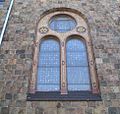Lukaskirche (Berlin)
The Evangelical St. Luke Church in the Berlin district of Steglitz was built between 1914 and 1919 according to plans by building officer Walter Kern . It is located on the green area of Friedrichsruher Platz, between Bergstrasse and Friedrichsruher Strasse on the edge of the so-called Bismarckviertel .
history
The Lukaskirche was built after the Matthäuskirche and the Markuskirche as the third church of the Steglitz community during the First World War and was consecrated on September 21, 1919. In World War II it was only slightly damaged. The Lukas parish became independent on December 19, 1949.
Building
The two- tower building complex, consisting of a three-aisled hall church along with the parish and parish house, was built in the neo-Romanesque style from granite boulders and looks like a castle. The historicist architectural style contrasts with the church buildings that were built at the same time, such as the neighboring St. Mark's Church , built in 1911 in contemporary reform architecture .
The design corresponds to the inscription above one of the side entrances on the side of the main portal, " A strong castle is our God ". At the time of construction, the church was only flanked in the east and west by multi-storey apartment buildings, with which it formed an architectural ensemble . The display sides in the north (Friedrichsruher Strasse) and south (Bergstrasse) were directly adjacent to gardens.
The round bell tower with a pointed conical roof on the north-west corner of the church is 56 meters high and follows the example of medieval fortification towers , as does the lower rectangular south-east tower with a tented roof. On the upper floor of the bell tower, there are three bronze bells that were cast in 1959 by the Rincker bell and art foundry .
| Chime | Weight (kg) |
Diameter ( cm) |
Height (cm) |
Crown (cm) |
inscription |
|---|---|---|---|---|---|
| h 0 | 2374 | 160 | 147 | 23 | ONE IS NOT + |
| d 1 | 1463 | 135 | 124 | 20th | LOOK, I PROMOTE GREAT JOY + |
| e 1 | 1100 | 122 | 112 | 19th | GLORY TO GOD ON THE HEIGHT + |
inner space
The interior of the church is now provided with simple plaster, but the mortar-cut ornaments on the galleries and on the ceiling of today's front church give an idea of the once magnificent design of the church interior. The vault of the nave was painted in color, the tinted walls were provided with ornamental lines. Only the triumphal arch of the altar apse, which was restored after the Second World War and which once found its artistic counterpart in the organ triumphal arch, has survived of this splendor .
While the altar apse is now entirely made of mosaic stones, these were originally limited to the dome and the depiction of Christ enthroned and the final frieze with symbols of the evangelists . Most of the apse was designed with four rows of mortar-cut cassettes, which were bordered at the bottom by a gray-blue stucco lustro cladding. Altar and baptismal font have hardly changed since then, apart from the fact that the three-dimensional representation of the baptism of Christ above the baptismal font had a marble crown with a gold-colored mosaic frieze.
The pulpit has hardly changed since then, only the then provisionally placed in the four figure African statuettes have been replaced in the meantime. At the time the Lukas Church was completed, these casts of the Christian virtues from the state museums had been made use of , as the still empty niches were perceived as unsatisfactory. But already at the inauguration of the church, the hope was expressed that these stylistic casts - based on the models of the two Italian sculptors Donatello and Jacopo della Quercia - would soon be replaced by appropriate new creations.
Today only the entrance hall on the ground floor of the main tower, designed as a memorial hall for the fallen of the First World War , has been preserved in its original state.
organ
The organ of the Lukaskirche goes back to an instrument that was built in 1919 by the organ building company Furtwängler und Hammer (Hanover) with 37 registers on three manuals and a pedal . The instrument survived the Second World War almost unscathed, but was replaced by a new instrument in 1964–1965, in which material from the Furtwängler & Hammer organ was reused. The sound of the instrument was improved in 2007 as part of a comprehensive repair and overhaul. Today it has 44 stops on three manuals and a pedal.
|
|
|
|
||||||||||||||||||||||||||||||||||||||||||||||||||||||||||||||||||||||||||||||||||||||||||||||||||||||||||||||||||||||||||||||||||||||||||||||||||||||||||||||||||||||||||||||||||||||||||||||||||||||||
-
Pairing :
- Normal coupling: II / I, III / I, III / II, I / P, II / P, III / P
- Super octave coupling: III / I, III / II, III / III
- Playing aids : 4000-fold setting system (Remocard), crescendo roller (4 programs)
gallery
A church window (mosaic by Puhl & Wagner ?)
West side entrance, so-called "iron door" (also nail portal, a solid castle is our god )
literature
- Günther Kühne, Elisabeth Stephani: Evangelical churches in Berlin. Berlin 1978.
- Klaus-Dieter Wille: The bells of Berlin (West). History and inventory. Berlin 1987.
- Architects and Engineers Association of Berlin: Berlin and its buildings. Part VI. Sacred buildings. Berlin 1997.
- Christine Goetz , Matthias Hoffmann-Tauschwitz: Churches Berlin Potsdam. Berlin 2003.
Web links
Individual evidence
- ^ The Evangelical St. Luke Church in Berlin-Steglitz
- ↑ St. Luke's Memorial Hall
- ↑ Instruments. Music website of the Protestant parishes Lukas and Südende in Berlin-Steglitz, accessed on May 26, 2019.
Coordinates: 52 ° 27 '32.6 " N , 13 ° 20' 9.9" E




